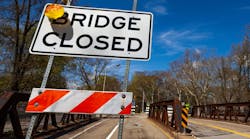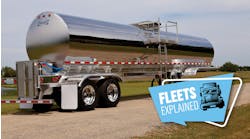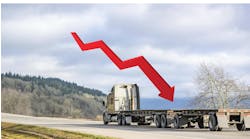There’s a lot about trucking among the 2,700-page bipartisan infrastructure bill up for consideration in the Senate. The bill, which totals about $1.2 trillion, would increase safety systems for commercial vehicles, focus on finding new drivers and other workers for the trucking industry, and test out ways to tax the alternate-powered vehicles of the future.
Unlike the House version, the Senate’s bill does not increase carriers’ $750,000 liability insurance minimum, which a House amendment wants to increase to $2 million. This bill also does not address the truck parking shortage or independent contractor rules, such as California's AB-5, which could limit how owner-operators work within the industry.
Eventually, the two sides of Congress would have to agree to one overall bill. With Democrats’ slim majority in the Senate and President Joe Biden aiming to make infrastructure the signature accomplishment of his first year in office, the Senate looks to have a little more say if its bill is approved.
While there are still steps to go before Biden would get an infrastructure bill to sign, Dave Heller, the Truckload Carriers Association vice president of governmental affairs, is pleased a bill made it this far. “Our congressional representatives are saying now’s the time for infrastructure. We need to come up with a bill that makes sense and keeps the conversation going,” Heller told FleetOwner. “I think that’s good news.”
Heller notes that while the bill could be a massive $1 trillion package, not all of that is new money. Some money is leftover from previous COVID-19 stimulus packages.
Highway Trust Fund
About $550 billion of the proposed $1 trillion would be new federal spending. But the rest of the bill would be paid for by various Congressional financing mechanisms, including using more than $200 billion in leftover coronavirus funding.
“As this Delta variant becomes more prevalent, the question is: Are those dollars already spoken for? Is this real money?” Heller asked. “That is becoming the bigger question, which also goes back to the self-sustaining Highway Trust Fund (HTF) argument. If you have that, you don’t have to pull dollars from other programs. You have a self-sustaining funding mechanism that could be paid for right at the pump with real dollars, easily collected, easily distributed.”
While Heller is happy to see Congress get closer to fixing roads and bridges, he said the federal government’s near abandonment of keeping the HTF sustainable just means that U.S. infrastructure will always be dependent on politics. The last time Congress raised the fuel tax, which funds the HTF, was in 1993.
The Senate proposal includes a vehicle miles traveled (VMT) pilot program that would look at how to tax cars and trucks with per-mile user fees to fund the HTF. With a push for more electric-powered vehicles—and as vehicles have become more fuel-efficient—gasoline and diesel taxes can’t keep the HTF solvent. At least three times this century, Congress has had to transfer billions of dollars from its General Fund to the HTF.
About $550 billion of the proposed bill includes new federal spending on hard infrastructure, including $40 billion for bridge repairs and $7.5 billion to build a national charging station network for electric vehicles. The new funding would also include more than $70 billion to rebuild the electric grid, $66 billion for freight and passenger rail, $65 billion to expand broadband Internet access, and $39 billion for public transit.
Other financing mechanisms would be used to pay for the other half of the bill. That money would bring the total spent on improving roads, bridges, and other major transportation projects to $110 billion.
More trucking interests
The Senate’s proposal, which Majority Leader Chuck Schumer (D-New York) said he wants a vote on this month, also includes other items of interest to the trucking industry. Here’s a quick rundown:
AEB: The bill calls for all commercial vehicles to be equipped with automatic emergency braking (AEB) systems within two years. Heller notes that most trucks are being built with this technology. “AEB technology is proven to stop accidents from happening,” he said. “Our members at TCA support that type of technology. We give that language in the bill a big thumbs up.”
The 20 automakers that produce 99% of the new passenger vehicles in the U.S. agreed to make AEB standard by September 2022 based on a voluntary commitment brokered by Insurance Institute for Highway Safety and the National Highway Safety Administration during the Obama administration.
“We as an industry need to look to prevent accidents, not justify them,” Heller said.
Underride guards: Underride guards on the back of trailers would become the law under the current proposal. These devices keep passenger cars that crash into the back of trucks and trailers from sliding beneath the trailer and severely injuring car occupants.
Trailers without them could put the vehicle out of service during roadside inspections if this bill passes. It also calls for a study on the effectiveness of side underride guards for trailers. Supporters point to crash studies done by the Insurance Institute for Highway Safety two years ago that demonstrated the effectiveness of side underride guard systems in protecting automobile occupants in a 30-mph crash.
Heller notes that most trailers have rear guards now but that the side guards need more testing.
Workforce outreach: The proposed bill includes a few initiatives to grow the trucking workforce. From public service campaigns to “increase awareness of career opportunities in the transportation sector” to an apprenticeship program for drivers younger than 21 to work in interstate commerce, the bill addresses the growing truck driver shortage across the country.
“Younger drivers, certainly drivers under the age of 21, have never truly been exposed to interstate trucking,” Heller notes. “That it appears in this (bill) is a good victory for the industry that’s advocated for this demographic. The lack of qualified drivers out there is certainly no secret to anybody involved in trucking. This is an opportunity to expand the trucking workforce.”
Like TCA, the American Trucking Associations have supported previous legislation to explore expanding interstate trucking to drivers younger than 21 years old. However, the Owner-Operator Independent Drivers Association has contended that for road safety, age commercial driver age requirements should be higher, not lower.
Women in trucking: Along with finding younger drivers, the bill promotes women in trucking. While women make up 47% of the U.S. workforce, they make up just 24% of all transportation and warehousing jobs, the bill notes. Just 6.6% of truck drivers are women and women own only 8% of freight firms. The bill notes that adding women to the driver workforce could also make the roads safer, as women are 20% less likely than men to be involved in a truck crash.
The bill calls for creating a Women of Trucking Advisory Board to encourage more women to enter the field.
Truck leasing task force: The Senate’s bill also wants to create a task force to examine commercial truck leasing agreements. It would look at how the agreements affect vehicle maintenance frequency and safe operations, including driver compliance.
Largest infrastructure bill in history
While previous presidents have tried to get big infrastructure bills through Congress, none have come close to what the current proposal could do. If this bill passes, it would be the most significant infrastructure spending in U.S. history.
“The status of our infrastructure has become more emergent in nature than ever before,” Heller said. “When you're shutting down a major freight lane, like that I-40 bridge in Memphis because it has a crack that affects structural stability, that is a problem.”
Heller also added that “this is probably the biggest step forward we've made since the fuel tax was last increased in 1993. There's no doubt about that. We need to fix our nation's bridges and roadways. It is the office place for the professional truck driver. My employers want to give me a good office place to work in—I think we want to provide our truck drivers with a great office place to work.”
But that still leaves Heller with a lingering question, 28 years since the fuel tax was last increased: “Are we having the same conversation 20 years from now? The key to infrastructure is making the Highway Trust Fund self-sustainable, so we don’t have to continue waiting until the situation gets dire before we get funding for these roads and bridges.”




